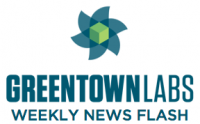ICYMI: last week a report from the Environmental Entrepreneurs announced the U.S. clean energy industry employs more than 2.5 million people; an investor out of Palo Alto encouraged all entrepreneurs to reconsider cleantech; the Institute for Energy and Sustainability launched the Worcester, MA Cleantech Incubator; and a researcher argued that the U.S. needs new high-voltage, long-distance power lines.
What other energy and cleantech related articles did you enjoy last week? Please let us know at @GreentownLabs. Happy reading! 😉
Boston Globe: State Seeks to Take Over Water Pollution Regulation from the EPA
After decades of ceding control to the federal government, state environmental officials are moving quickly to assert authority over the amount of pollution allowed in the state’s waterways, a decision environmental advocates fear could weaken protections and harm water quality.
CNBC: Clean energy employs 2.5 million in US: Report
The clean energy industry in the U.S. employs over 2.5 million people, according to new analysis released by Environmental Entrepreneurs (E2), a nonpartisan business group.
Fortune: Why Every Entrepreneur Should Take a Closer Look at Clean Tech
Rather than emphasizing technology breakthroughs, this new wave of clean-tech businesses is all about finding applications and solutions. They will take existing, core technologies and combine them with software, the cloud, and sensors to build new products and services.
Huffington Post: This Messaging Guru is Helping Utilities Clean Up Their Appearance
The U.S. utility industry, beset by stricter pollution regulations and market forces that have made renewable energy more competitive, is seeking to rebrand itself into something more appealing to the public.
MIT Technology Review: A Xerox Machine for Super Solar Panels
Researchers at PARC, an R&D-focused subsidiary of Xerox, say they’re developing a new digital printing process that could make it much cheaper to mass-produce concentrated solar photovoltaic systems. Such systems can dramatically increase the efficiency of solar cells by using lenses to concentrate and focus the sunlight onto small cells.
Telegram: Incubating the Next Generation of Cleantech in Worcester, MA
The Institute for Energy and Sustainability officially cut the ribbon on the Worcester CleanTech Incubator Thursday, hosting about 150 clean technology entrepreneurs, business leaders and municipal workers in its 11,000 square foot space in the Printers Building for a grand opening and a conference run by the Northeast Clean Energy Council.
The Washington Post: Scientists Nearly Double Sea Level Rise Projections for 2100, because of Antarctica
Sea levels could rise nearly twice as much as previously predicted by the end of this century if carbon dioxide emissions continue unabated, an outcome that could devastate coastal communities around the globe, according to new research.
Wind and sunlight have many advantages as fuel sources, but one big drawback is that they aren’t portable. You can’t carry them to a power plant. You have to build the power plant wherever you find them.That puts the US in an awkward situation, because the most intense wind and sunlight tend to be found in remote, low-population areas — think the sunny desert Southwest or the windy Great Plains.In order to exploit that wind and sunlight, the US needs some way to carry the power generated there to the population centers where it’s needed.


